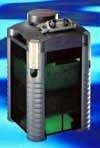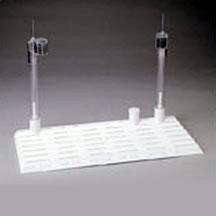Why and how to use undergravel filters in fish tanks
Quick links - Answers
Brief Description
Old, familiar, outdated, problematic, simple, reliable, they have been called all of these and more, depending on who you ask. Please note: During this guide, I am attempting to give a balanced view and not condemning any specific filter or manufacturer. I have chosen Eheim in this guide purely because they are a well-known brand with a good reputation.
Introduction
Under Gravel Filters, (UGF), were the first type of filter made available for aquarists. Although they have a long and proven record, many aquarists have turned their backs on these in favour of more powerful, and more expensive filters.
The undergravel filter is a simple biological filter, using a shaped plastic plate which lays on the bottom of the tank with slots cut into it to allow water through into the gullies of the moulding, and a riser tube to draw the water back to the surface with the aid of an airstone or powerhead. The plate is covered with gravel and that’s it!
It works very effectively by pulling water down through the gravel, where the solid debris is trapped close to the surface, and the soluble waste is broken down by bacteria that grows on the gravel surface further down. The clean water is then taken back to the surface by the airstone or powerhead. A quiet, effective, simple to maintain and inexpensive system, so why don’t more people use them?
There are various reasons for their decline in popularity, not least the problems that have been associated with cleaning them. Although this is not a weekly or even monthly task, it can involve a great deal of effort. The traditional way to clean this type of filter is by completely emptying the tank, removing the gravel, plants, ornaments etc, lifting the plate, rinsing it under the tap and putting it all back together, washing the gravel and everything else before putting it back in. Not a pleasant task and very stressful for the inhabitants, catastrophic for the biological bacteria and very time consuming.
If that has put you off, read on, because there are much simpler and less stressful ways to clean them. I use a wet/dry vacuum cleaner to clean mine every three months, (I have as many as 15 running most of the time), and it takes me 5 minutes each! I don’t have to take anything out, not even the fish, don’t disturb the plants or ornaments, and the bacteria stays intact. I simply connect my wet/dry vacuum hose to the riser tube and switch on for a few seconds. The force of the water being pulled through the gravel does the cleaning for me and all I have to do afterwards is top up the level. Regular gravel vacuum takes a few minutes a week and is done as part of the maintenance regime, but this needs to be done whatever type of filter you use!
The second most popular reason for their decline is the movement away from gravel as a substrate. Many aquarists have gone for sand, peat and other substrates better able to maintain planted aquariums. This is not suitable for undergravel filters because the fine grains will clog up the gullies and slots, so they become useless. In this situation, undergravel filters cannot be used.
Another probable cause for the decline in popularity has been the move to mechanical, chemical and biological filtration, instead of just biological. This does improve the water conditions, leads to much clearer water and better filtration, but at a cost. This type of filter is very expensive in comparison, much more difficult to maintain and can be noisy, unsightly and bulky. They come in a variety of disguises, from in-tank to canister. All these have their good points and bad, but I’m not going into them now, since this guide is about undergravel filters.
The last major “nail in the coffin” of undergravel filters has been manufacturers and retailers looking for sales and profit. It is my belief that retailers sell away from undergravel filters because they don’t make any money from them! When you look at the filter, it costs a few dollars for the plate, which comes complete with airstone, and a few dollars more for an air pump or powerhead. That is the total cost of the filter, except that twice a year you need to replace the airstone, should you choose this method. Power filters are totally different, since the initial cost is far greater, they use disposable media and various other components in their make-up, and all these things will keep you going back to the shop, spending money. A pack of media inserts for a small in-tank filter will cost as much as the complete undergravel filter and last a couple of months, whereas the undergravel filters will last for years!
Next time you go to your local fish store, take a look at the filters and ask about a undergravel filter, just to see what they say. Most staff will sell you away from them and try to sell you something much more expensive.
Now I’ve had my say on that subject, let’s get back to the filter in question. Is there still a place in the hobby for undergravel filters? Most definitely! I am not biased here, I have nothing to gain by promoting these filters, but I do believe that many of us spend lots of money needlessly, especially where filters are concerned. After the purchase of the tank, what is the single most expensive item? The filter, most would say.
$40 - $300 on a filter is not unreasonable these days. Often, they are more expensive than the tank itself! Bearing in mind that the inhabitants of the tank may match or even exceed this cost is not a valid argument for spending horrible amounts of money.

This is an Eheim Canister filter for tanks with a capacity of 55 gallons maximum. In the UK, this filter will cost around $140 from an online store.
Image source: aquatics-warehouse.co.uk
A undergravel filter will cost you less than $40 for most tanks up to 40 gallons and can be doubled for larger tanks. An air pump will cost you $10 - $40 depending on the size and amount of flow required.

Penn Plax Undertow Undergravel Filter (55/40L/60 Gallon)
This is a good example of a undergravel filter that will do the same job. It costs $40 retail.
Image source: aquariumpros.com
Even with the additional cost of a powerhead, (I have selected one by Hagen for this guide, which has sufficient flow to cater for 50 gallon - 223.3 litre, 60.05 US gallon - tanks), at a cost of another $35 from the same website, you are still well below the cost of the canister filter.
Still wondering which filter to use? Let’s look at the advantages and disadvantages, other than cost.
Placement:
The Eheim canister filter pictured above is an external filter, which means that it needs a place to live outside the aquarium. Most stands have cupboards underneath, and this would be the logical place for it. The undergravel filter is an internal filter, requiring no additional space.
Flow methods:
The Eheim has two pipes running from the tank to the filter. These are not easily hidden and tend to be quite rigid, so you have an aesthetics problem. You also need to modify your lighting canopy to allow these pipes to hook over the top of the tank.
The undergravel filter has one or two riser pipes, which are of transparent plastic, so are easy to disguise, and they don’t leave the tank, so no problems with interference of canopies etc. If fitted with a powerhead, there is a power cable that runs over the top of the tank to the supply. If run by air, the airline needs top leave by the same route. This normally does not cause any problems with the canopy.
Media:
The Eheim does have re-usable media, which can be rinsed and replaced several times, but activated carbon has to be changed regularly.
The undergravel filter uses gravel as its media and this doesn’t need changing. Additional activated carbon blocks are available for the top of the risers if required, and these would need to be replaced periodically.
Maintenance:
Regular maintenance of the Eheim is easy, by just shutting off the taps on the top of the filter unit and opening it up to gain access to the media inside, but they have been known to cause floods when the taps aren’t shut off properly.
The undergravel filter doesn’t require regular maintenance, just the routine detailed above.
Filtration ability:
The Eheim has three stage filtration, in the form of mechanical, chemical and biological filters.
The undergravel filter can have two stage with the addition of activated carbon blocks. Some could argue that they have the three stages, since the mechanical filtration is removal of the larger debris, which the undergravel filter does by trapping it in the upper layers of the gravel. (I get confused over this one myself)
Circulation:
The Eheim causes strong currents in the tank as the water leaves the outlet pipe with force. Addition of a spray-bar will reduce this if required.
A undergravel filter under airstone operation creates a gentle current, which is advantageous for some inhabitants that don’t like strong currents. With the undergravel filter using powerheads the current is of similar force to the Eheim. There is another benefit with the undergravel filters that hasn’t been mentioned yet. As the filter tray pulls water from the whole bottom surface area, the temperature is more consistant throughout the tank, especially if the riser is placed next to the heater.
Safety:
The Eheim has a single inlet pipe which can catch small fish and suck them in. It requires a pre-filter mesh or foam to avoid this problem but can still trap smaller fish against the pre-filter.
The undergravel filter has its intake under the gravel, which is totally fish-safe. It can actually be beneficial to the fish during spawning, as it pulls the eggs into the top layer of gravel away from the adults, allowing for better survival of young. It is also safe for all small fish and invertebrates too.
Have I convinced you yet that there is room for undergravel filters in the hobby? Another consideration could be that you combine the two types to obtain the best possible results. A undergravel filter in conjunction with a smaller power filter works very well and other uses for the UGF are coming out now too. There is the idea that by using it backwards, that is to push the water down the riser and out through the gravel, it creates excellent circulation. It doesn’t work as a filter any more, just creates undercurrents that some fish enjoy, as well as lifting debris from the bottom for the power filter to catch. Using it this way apparently reduces tank maintenance, but I have not tried it yet, so its only supposition in my view. The theory is sound though, so it could work.
Whatever you decide to use for your aquarium, enjoy the hobby, appreciate your pets and be prepared to experiment. Nothing is cast in stone with this hobby, and everyone is open to new ideas and methods.
Enjoy!
